So autumn is here and, in case you weren’t convinced, you only have to look at the birds, insects and other wildlife to see their response to shorter days, colder nights and a ripe harvest.

The most common large web weaver is the Garden spider, Araneus diadematus
About a month ago my early morning wander around the garden started to become a sticky affair. Large, taut spiral webs were being strung across every path and doorway. I can’t count the number of times I walked into the greenhouse and straight into a web. Most of these daily (unless I manage to avoid them) constructions are made by the Garden spider, Araneus diadematus. Garden spiders are easily identified by the white cruciform markings on their back. Females are frequently seen suspended in the centre of the webs and can be quite large (up to 13mm cf. 8mm for the male) particularly at this time of year when they are likely full of eggs. Sadly, after laying their eggs the spider will die, leaving an egg sac attached to some sturdy branch, fence or shed to weather the winter.
In the back garden I’ve been watching various fruits fall to the ground in increasing numbers. I use as much as I can, but the crop is heavy and there is definitely a limit to how much jam/jelly/gin I can usefully make. So the damson trees are chock-full of wood pigeons eating as many as they can! My dog, Sadie, is a hoover for the fallen fruit, so her visits outside are strictly monitored. She is a big fan of apples too and being part labrador she has no OFF switch. This can be problematic when I lose her in the set-aside copses for long periods of time.
Apples are the main crop of choice with the birds and insects too. All that lovely sugar I suppose. The blackbirds are especially fond of them, but wasps and butterflies (Red Admirals largely) can often be found sampling them once they’ve been pecked open. Interestingly, the local rooks, who usually hang out in the sheep field behind us, seem to have recently become keen on apples too, which I’ve not seen before.

Rooks enjoying the fallen apples
It wouldn’t be autumn without squirrels bouncing around the gardening eating the nuts (I have walnuts and hazel nuts) and making holes in the lawn as they bury others. The black squirrels are back, but I only managed a photo of a normal grey one. I am not sure whether they partake of the apples too, but there are tooth marks consistent with small mammals (could be rats of course!).
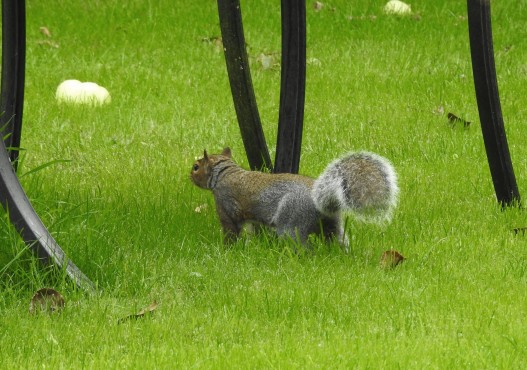
Where did I bury that hazel nut?
Robins are more visible in the garden. Well, they are bright red, so may be I mean more present rather than visible.

Robins are once more obvious, singing at the top of the bare branches in the hedge
As well as felling the fruit, the winds recently have been whipping everyone’s hair/feathers into a mess!
I don’t know whether the winds have been a contributing factor, but there has been a sorry lack of butterflies this autumn. Fortunately, asters can still work their magic on the ones that remain, so it is well worth having these in the borders.
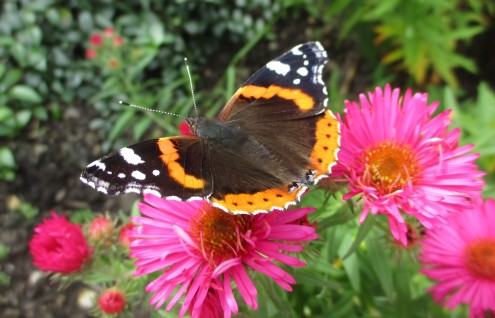
Red Admiral on S. ‘Andenken an Alma Pötschke’
It is always fun to be in the garden when the tit flock swoops in. They are very inclusive and fill the trees and bushes all around you, so that you feel part of their crazy party. Their tribe usually consists of long-tailed tits, great tits, blue tits and coal tits, but you can often see other participants caught up in the frenzy, such as the goldcrests.
Last time they blew in, they had swept up this timid visitor. I couldn’t really make out what it was. I think that last time I saw it I though it was a garden warbler.
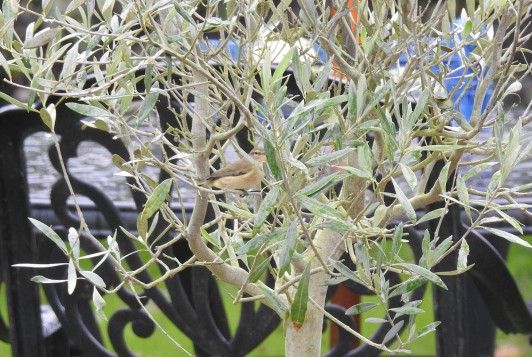
This new visitor arrived with the tit flock
Happily, my waiting game with the camera paid off, because I was able to get a clear view when the rock fountain proved too much temptation. I now believe him to be a common chiffchaff. The responses to the ID on the iSpot website have agreed with this assessment so far.
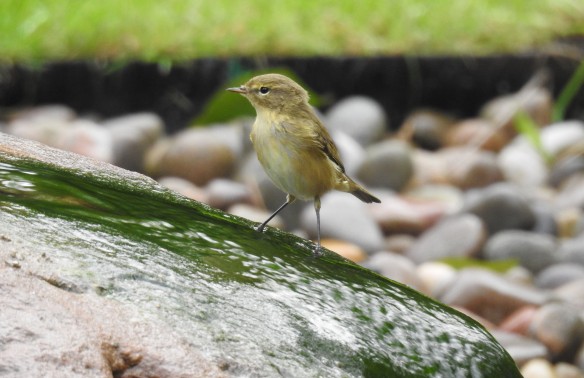
Chiffchaff on the fountain
Welcome chiffchaff!
We are seeing quite a lot of woodpecker activity in the garden again. The Great Spotted woodpeckers are usually to be seen hopping up the damson trees, but this fresh-looking fellow was experimenting with the potted olives and then the water fountain.

Great spotted woodpecker hopping up a young olive tree.
The juvenile green woodpecker is still a regular visitor, but he is usually on the ground, pecking for insects and grubs. He is looking particularly scruffy as his plumage changes.
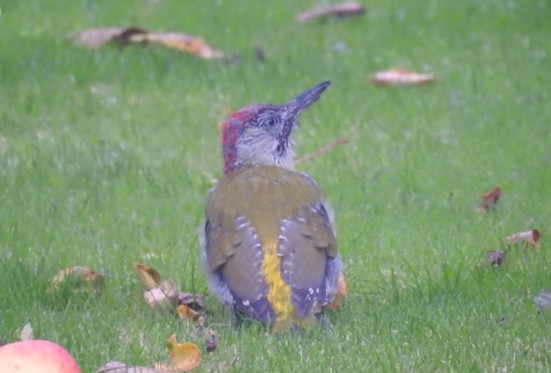
Our scuffy looking juvenile green woodpecker
I’ve mentioned the ripe harvest of fruit and nuts, but seeds play a big role in attracting wildlife too. Sunflowers are one of the most obvious seed supplies and are especially loved by greenfinches, but I always grow some teasel in the garden for the goldfinches too.

Teasel crop at Wimpole
Gardening at a National Trust property like Wimpole allows planting on a large scale, which is part of the fun of course. Here is their stand of teasel for instance (above).
Last week I was wheeling weeds to the bund passed this large stand when the whole area erupted with squawked alarm calls as birds flew for the surrounding trees. Sure enough the birds were goldfinches. I’d estimate that there were probably 40-50 birds in the stand. This photo show just some of them in the nearest tree.

A charm of Goldfinches
Are you seeing changes in your wildlife visitors as autumn settles in??
I am linking up to Tina’s monthly Wildlife Wednesday. I know that I am bit late, but I am hoping that she won’t mind a tardy entry. 🙂

Great photos!
Thanks
A great variety of critters to share, Allison! Gorgeous spider shot, as well as the photogenic birds! It’s nice to see a new bird and even better (or at least confirming) to identify it. I read once that in fact, squirrels can remember where they put most of their treasures, and that they actually retrieve them, but I’m not buying it–I find too many wayward oak seedings to believe that! Great post and thanks (as always!) for joining in–it’s a treat!
That spider was a looker! Squirrels maybe have a deliberate policy of leaving every nth nut to grow into a new tree, but on balance they certainly seem forgetful. I have hazels everywhere rather than oak.
You can feel the ramping up urgency in the wild critters. Squirrels and chipmunks are frenetic and scolding constantly (driving the dog and me crazy) and unlike you, we’ve had a bumper crop of migrating butterflies (they say we had double broods of Painted Ladies this summer) and more monarchs than I have seen in years – which fills me with hope for this species. Lots of Vs of geese overhead, and white-throated sparrows in the undergrowth. They’re letting us know winter is coming!
So glad to hear about your monarchs, it does seem to be a trend I am hearing a lot of this year, so yes, cautious optimism. On Monday I heard the first geese arriving at Wimpole. They are an impressive sight as they fly over! Are white-throated sparrows migrants?
Yes, WT sparrows breed in the boreal forests of Canada, so we get their large flocks moving north or south, telling us the season is turning spring or fall. Their voice is so sweet: https://www.allaboutbirds.org/guide/White-throated_Sparrow/sounds My gramma used to say they are singing, “Ol’ Sam Peabody-Peabody-Peabody” 🙂
Great post and love all your photos! I’m sure the rooks wouldn’t miss the opportunity for a free feed even if its apples. And what interested me the most was the woodpecker. We don’t have any here in Australia, I’d love to see one in action! 🙂
Thanks Sue. One year we had a Great Spotted woodpecker make a nest/hole in the rotting tree that use to hold up one end of my washing line, but I sadly didn’t get to see it drill. (It did raise a family successfully though!) Did you add an extension or app to your WordPress to show videos, ‘cos it looks like I can’t load them automatically?
I’m not sure why you’re having trouble with the videos. Occasionally I use WordPress Video, but almost all my videos are from YouTube. If you still have trouble, let me know which post it is and I’ll see if I can work out what the issue is. 🙂
Beautiful images and what a wonderful garden for wildlife to thrive in! I really like the photo of that little Chiffchaff on the fountain 🙂
Thanks. I’ve found it works well to take photos when the birds drop in en masse and are making too much fuss amongst themselves, then I can quietly sit at the table watching and snapping.
Great post! I love your species of Woodpecker – especially the green one! Also the tree full of goldfinches. I’ve seen very few Red Admirals this year, which is sad.
Thank you. Interesting to hear about your low Red Admiral numbers this year. Our weather in July/August was too blame, I believe, for our poor showing.